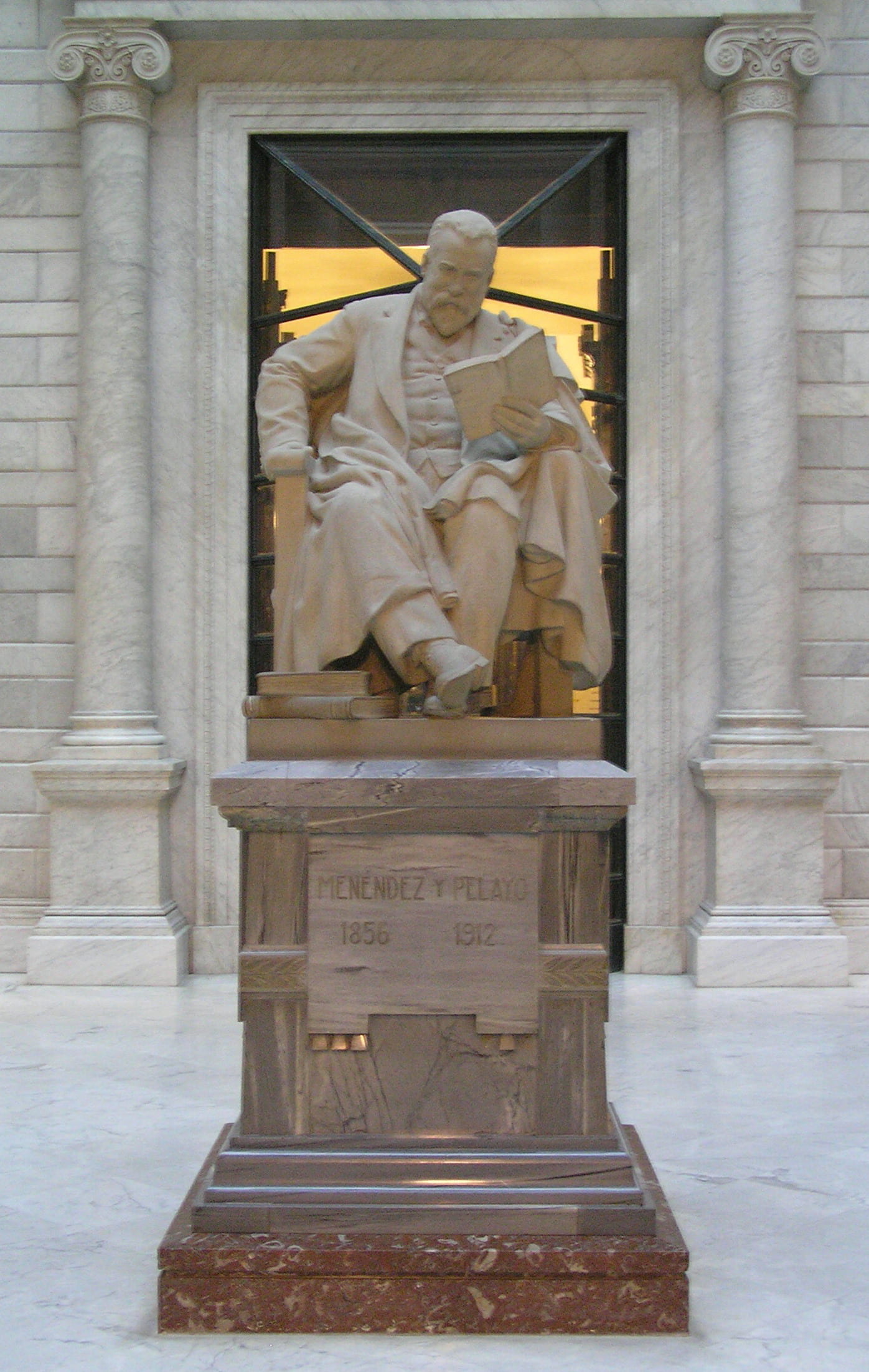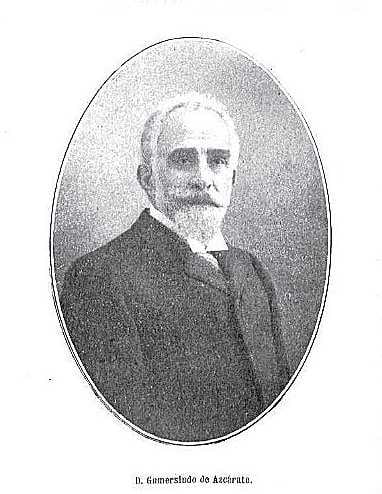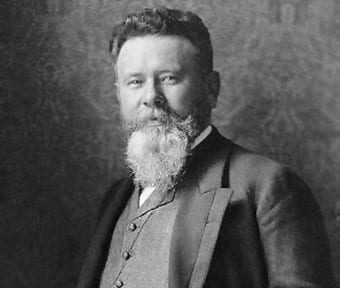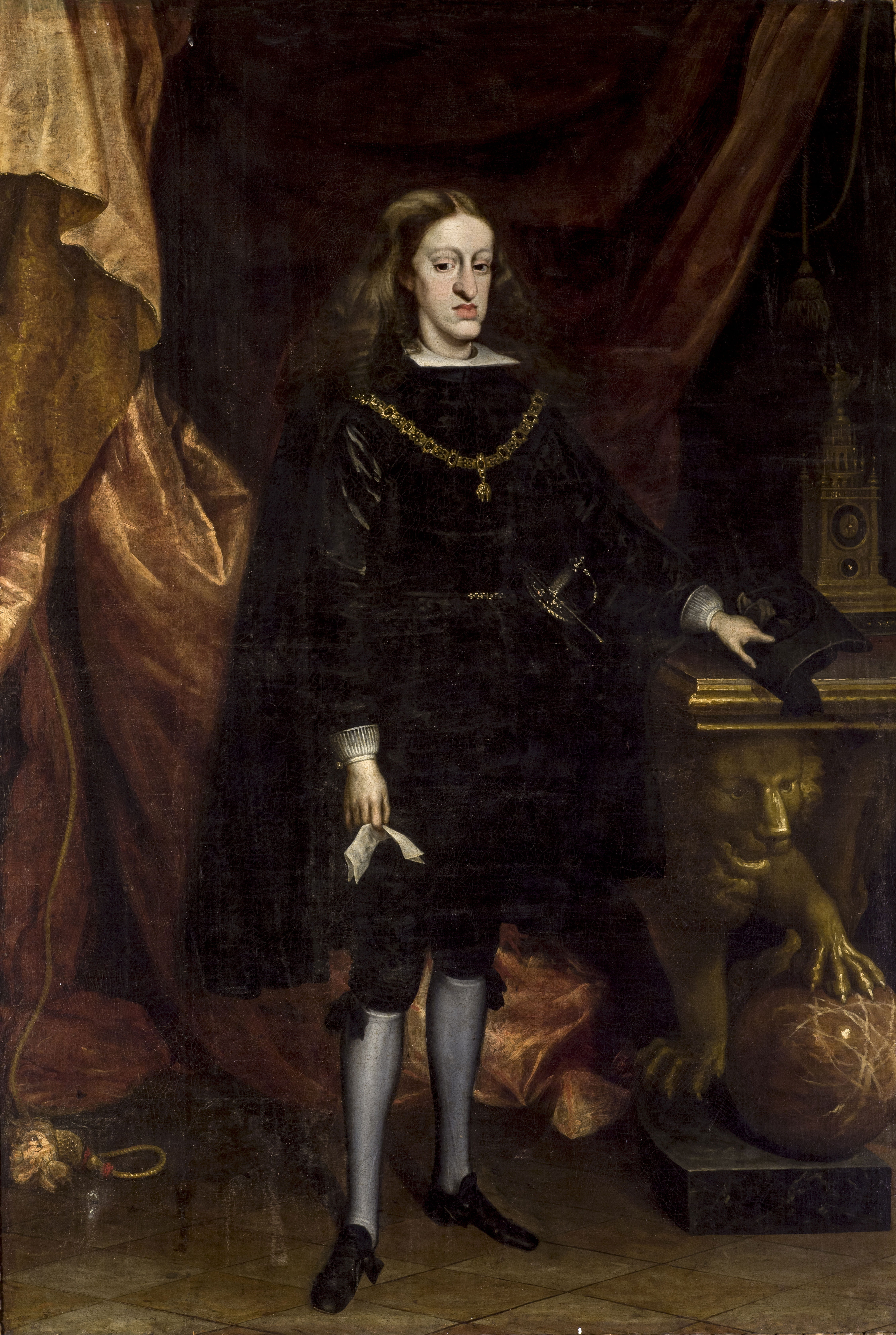By Editor Spencer J. Weinreich

Statue of Marcelino Menéndez Pelayo at the Biblioteca Nacional de España
Marcelino Menéndez y Pelayo’s La ciencia española (first ed. 1876) is a battlefield long after the guns have fallen silent: the soldiers dead, the armies disbanded, even the names of the belligerent nations changed beyond recognition. All the mess has been cleared up. Like his contemporaries Leopold von Ranke, Arnold Toynbee, or Jacob Burckhardt, Menéndez Pelayo has been enshrined as one of the nineteenth-century tutelary deities of intellectual history. Seemingly incapable of writing except at great length and in torrential cascades of erudition, his oeuvre lends itself to reverence—and frightens off most readers. And while reverence is hardly undeserved, we do a disservice to La ciencia española and its author if we leave the marmoreal exterior undisturbed. The challenge for the modern reader is to recover the passions—intellectual, political, and personal—animating what Menéndez Pelayo himself called “a book of battle [un libro de batalla]” (2:268).

Gumersindo de Azcárate
La ciencia española is a multifarious collection of articles, reviews, speeches, and letters that takes its name from its linchpin, a feisty exchange over the history of Spanish learning (la ciencia española). The casus belli came from an 1876 article by the distinguished philosopher and jurist Gumersindo de Azcárate, who argued that early modern Spain had been intellectually stunted by the Catholic Church. Menéndez Pelayo responded with an essay vociferously defending the honor of Spanish learning, exonerating the Church, and decrying the neglect of early modern Spanish intellectual history. Azcárate never replied, but his colleagues Manuel de la Revilla, Nicolás Salméron, and José del Perojo took up his cause, trading articles with Menéndez Pelayo in which they debated these and related issues—was there such a thing as “Spanish philosophy”?—in excruciating detail.
The exchange showcases the driving concerns of Menéndez Pelayo’s scholarly career: the greatness of the Spanish intellectual tradition, critical bibliography, Catholicism as the national genius of Spain, and an almost-frightening sense of how much these issues matter. This last is the least accessible element of La ciencia española: the height of its stakes. Why should Spain’s very identity rest upon abstruse questions of intellectual history? How did a group of academics merit the label “the eternal enemies of religion and the patria [los perpetuos enemigos de la Religión y de la patria]” (1:368)?
Here we must understand that La ciencia española is but one rather pitched battle in a broader war. Nineteenth-century Spain was in the throes of an identity crisis, the so-called “problem of Spain.” In the wake of the loss of a worldwide empire, serial revolutions and civil wars, a brief flirtation with a republic, endemic corruption, and economic stagnation, where was Spain’s salvation to be found—in the past or in the future? With the Church or with the Enlightenment? By looking inward or looking outward?

Karl Christian Friedrich Krause
Menéndez Pelayo was a self-declared neocatólico, a movement of conservative Catholics for whom Spain’s identity was indissolubly linked to the Church. He also stands as perhaps the foremost exponent of casticismo, a literary and cultural nationalism premised on a return to Spain’s innate, authentic identity. All of Menéndez Pelayo’s antagonists in that initial exchange—Azcárate, Revilla, Salmerón, and Perojo—were Krausists, from whom not much is heard these days. Karl Christian Friedrich Krause was a student of Schelling, Hegel, and Fichte, long (and not unjustly) overshadowed by his teachers. But Krause found an unlikely afterlife among a cohort of liberal thinkers in Restoration Spain. These latter-day Krausists aimed at the intellectual rejuvenation of Spain, which they felt had been stifled by the Catholic Church. Accordingly, they called for religious toleration, academic freedom, and, above all, an end to the Church’s monopoly over education.
To Menéndez Pelayo, Krausism threatened the very wellsprings of the national culture. The Krausists were “a horde of fanatical sectarians […] murky and repugnant to every independent soul” (qtd. in López-Morillas, 8). He acidly denied both that Spain’s learning had declined, and that the Church had in any way hindered it:
For this terrifying name of “Inquisition,” the child’s bogeyman and the simpleton’s scarecrow, is for many the solution to all problems, the deus ex machina that comes as a godsend in difficult situations. Why have we had no industry in Spain? Because of the Inquisition. Why have we had bad customs, as in all times and places, save in the blessed Arcadia of the bucolics? Because of the Inquisition. Why are we Spaniards lazy? Because of the Inquisition. Why are there bulls in Spain? Because of the Inquisition. Why do Spaniards take the siesta? Because of the Inquisition. Why were there bad lodgings and bad roads and bad food in Spain in the time of Madame D’Aulnoy? Because of the Inquisition, because of fanaticism, because of theocracy. [Porque ese terrorífico nombre de Inquisición, coco de niños y espantajo de bobos, es para muchos la solución de todos los problemas, el Deus ex machina que viene como llovido en situaciones apuradas. ¿Por qué no había industria en España? Por la Inquisición. ¿Por qué había malas costumbres, como en todos tiempos y países, excepto en la bienaventurada Arcadia de los bucólicos? Por la Inquisición. ¿Por qué somos holgazanes los españoles? Por la Inquisición. ¿Por qué hay toros en España? Por la Inquisición. ¿Por qué duermen los españoles la siesta? Por la Inquisición. ¿Por qué había malas posadas y malos caminos y malas comidas en España en tiempo de Mad. D’Aulnoy? Por la Inquisición, por el fanatismo, por la teocracia.]. (1:102–03)
What was called for was not—perish the thought—a move away from dogmatism, but a renewed appreciation for Spain’s magnificent heritage. “I desire only that the national spirit should be reborn […] that spirit that lives and beats at the base of all our systems, and gives them a certain aspect of their parentage, and connects and ties together even those most discordant and opposed [Quiero sólo que renazca el espíritu nacional […], ese espíritu que vive y palpita en el fondo de todos nuestros sistemas, y les da cierto aire de parentesco, y traba y enlaza hasta a los más discordes y opuestos]” (2:355).

Title page of Miguel Barnades Mainader’s Principios de botanica (1767)
Menéndez Pelayo practiced what he preached. He is as comfortable discussing such obscure peons of the Republic of Letters as the Portuguese theologian Manuel de Sá and the Catalan botanist Miguel Barnades Mainader, as he is in extolling Juan Luis Vives, arguing over the influence of Thomas Aquinas, or establishing the birthplace of Raymond Sebold. Menéndez Pelayo writes with genuine pain at “the lamentable oblivion and neglect in which we hold the nation’s intellectual glories [del lamentable olvido y abandono en que tenemos las glorias científicas nacionales]” (1:57). His fellow neocatólico Alejandro Pidal y Mon imagines Menéndez Pelayo as a necromancer, calling forth the spirits of long-dead intellectuals (1:276), a power on extravagant display in La ciencia española. The third volume of La ciencia española comprises nearly three hundred pages of annotated bibliography, on every conceivable branch of the history of knowledge in Spain.
I am aware how close I have strayed to the kind of pedestal-raising I deprecated at the outset. Fortunately, we do not have to look far to find the clay feet that will be the undoing of any such monument. Menéndez Pelayo’s lyricism should not disguise the reactionary character of his intellectual project, with its nationalism and loathing of secularism, religious toleration, and any challenge to Catholic orthodoxy. His avowed respect for the achievements of Jews and Muslims in medieval Spain is cheapened by a pervasive, muted anti-Semitism and Islamophobia: La ciencia española speaks of “the scientific poverty of the Semites [La penuria científica de los semitas]” (2:416) and the “decadence [decadencia]” of contemporary Islam. When he writes, “I am, thanks be to God, an Old Christian [gracias a Dios, soy cristiano viejo]” (2:265), we cannot pretend he is ignorant of the pernicious history of that term. Of the colonization of the New World he baldly states, “we sowed religion, science, and blood with a liberal hand, later to reap a long harvest of ingratitudes and disloyalties [sembramos a manos llenas religión, ciencia y sangre, para recoger más tarde larga cosecha de ingratitudes y deslealtades]” (2:15).
It is no coincidence that Menéndez Pelayo’s prejudices are conveyed in superlative Spanish prose—ire seems to have brought out the best of his wit. “I cannot but regret that Father [Joaquín] Fonseca should have felt himself obliged, in order to vindicate Saint Thomas [Aquinas] from imagined slights, to throw upon me all the corpulent folios of the saint’s works [no puedo menos de lastimarme de que el Padre Fonseca se haya creído obligado, para desagraviar a Santo Tomás de ofensas soñadas, a echarme encima todos los corpulentos infolios de las obras del Santo]” (2:151) “Mr. de la Revilla says that he has never belonged to the Hegelian school. Congratulations to him—his philosophical metamorphoses are of little interest to me [El Sr. de la Revilla dice que nunca ha pertenecido a la escuela hegeliana. En hora buena: me interesan poco sus transformaciones filosóficas]” (1:201). On subjects dear to his heart, baroque rhapsodies could flow from his pen. He spends three pages describing the life of the medieval Catalan polymath Ramon Llull, whom he calls the “knight errant of thought [caballero andante del pensamiento]” (2:372).
At the same time, many pages of La ciencia española make for turgid reading, bare catalogues of obscure Spanish authors and their yet more obscure publications.
* * *
Menéndez Pelayo died in 1912. Azcárate, his last surviving interlocutor, passed away five years later. Is the battle over? In the intervening decades, Spain has found neither cultural unity nor political coherence—and not for lack of trying. Reactionary Catholic and conservative though he was, Menéndez Pelayo does not fit the role of Francoist avant la lettre, in spite of the regime’s best efforts to coopt him. La ciencia española shows none of Franco’s Castilian chauvinism and suspicion of regionalism. Menéndez Pelayo chides an author for using the phrase “the Spanish language [la lengua española]” when he means “Castilian.” “The Catalan language is as Spanish as Castilian or Portuguese [Tan española es la lengua catalana como la castellana or la portuguesa]” (2:363).
Today the Church has indeed lost its iron grip on the Spanish educational system, and the nation is not only no longer officially Catholic, but has embraced religious toleration and even greater heterodoxies, among them divorce, same-sex marriage, and abortion. We are all Krausists now.
If the crusade against the Krausists failed, elements of Menéndez Pelayo’s intellectual project have fared considerably better. We are witnessing a flood of scholarly interest in early modern Spain’s intellectual history—historiography, antiquarianism, the natural sciences, publishing. Whether they know it or not, these scholars are answering a call sounded more than a century before. And never more so than when they turn their efforts to those Menéndez Pelayo sympathetically called “second-order talents [talentos de segundo orden]” (1:204). In the age of USTC, EEBO, Cervantes Virtual, Gallica, and countless similar resources, the discipline of bibliography he so cherished is expanding in directions he could never have imagined.

Charles II of Spain
Spain’s decline continues to inspire debate among historians—and will continue to do so, I expect, so long as there are historians to do the debating. The foreword to J. H. Elliott’s still-definitive survey, Imperial Spain: 1469–1716, places the word “decline” in inverted commas, but the prologue acknowledges the genuine puzzle of explaining the shift in Spain’s fortunes over the early modern period. Menéndez Pelayo could hardly deny that Charles II ruled an altogether less impressive realm than had his great-grandfather, but would presumably counter that whatever the geopolitics, Spanish letters remained vibrant. As for the Spanish Inquisition, his positivity prefigures that of Henry Kamen, who has raised not a few eyebrows with his favorably inclined “historical revision.”
La ciencia española is at once the showcase for a prodigious young talent, a call to arms for intellectual traditionalism, and a formidable if flawed collection of insights and reflections. As the grand old man of Spanish letters, a caricature of conservatism and Catholic partisanship, Menéndez Pelayo furnishes an excellent foil—or strawman, for those less charitably inclined—against whom generations can and should sharpen their pens and their arguments.
La lutte continue.


Leave a Reply